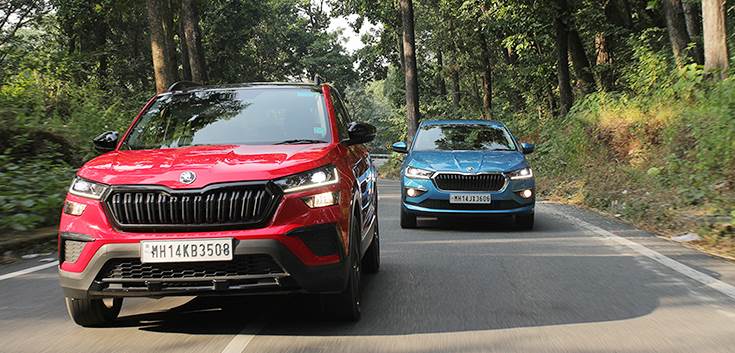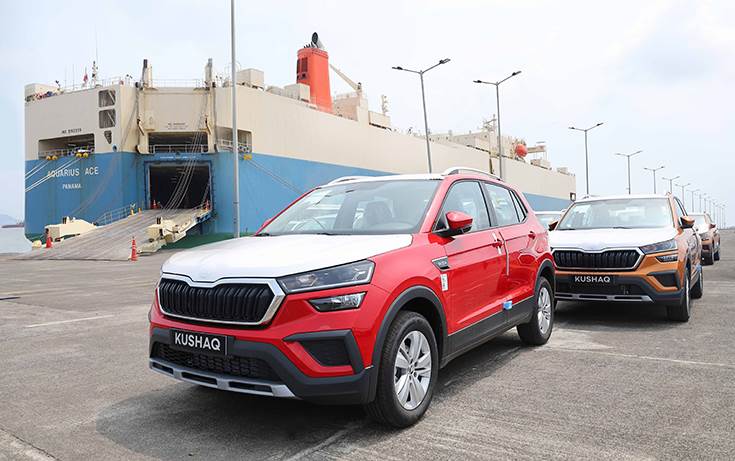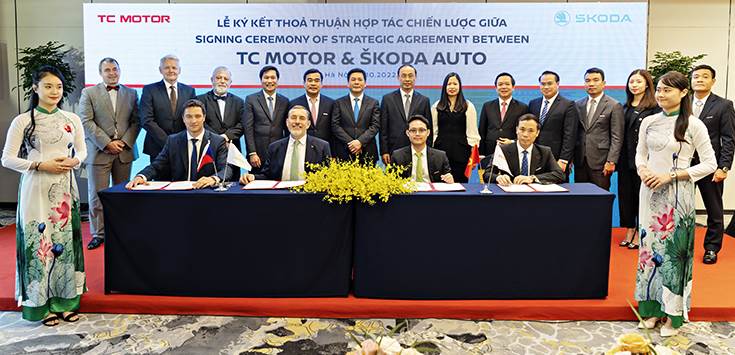Having built a modest base with India 2.0 products, Czech carmaker Skoda Auto is looking to build its presence in both the mainstream and the top end of the market, including electric vehicles.
In an exclusive interview to Autocar Professional on the sidelines of the IAA Mobility Show 2023 last week in Munich, Skoda Auto Klaus Zellmer CEO said the next phase of investment for India, which is for facelifted models and the upcoming sub-4-metre SUV in 2025, is approved and the brand is aiming to expand its addressable market in the coming years. Zellmer spoke about the journey so far, the evolution of the Indian market and the role of bigger vehicles, EVs and hybrids. Edited excerpts from the interview.
What is your view about the progress of the India 2.0 project and its growth potential, going forward?
We have two very solid products in the Kushaq and Slavia, made for India, in India. We are very proud of their safety ratings – they are the safest cars for families. In general, the quality perception is good.
As regards the sales numbers, we hope to beat last year’s sales and we need to catch up. We have boarded a lot of dealers . . . they still have to get into full swing and focused. Money is quite expensive at the moment and we need a good wholesale finance program, which we are discussing with our financial services colleagues. So, a couple of pieces of puzzle to be clipped in after which we can be more optimistic to hit the numbers and stay on a growth path.

2022 was really good. 2023 is going to be a challenge to beat 2022, but we haven’t given up yet.
In terms of profitability, we’re on a good way but we haven’t hit where we want to be yet. That’s related to the sales numbers that we don’t hit at the moment, but we’re catching up.
New products are key for the India market. What should one expect?
We are always looking above and below the Kushaq and Slavia for more potential. In late 2024, there might be big news for that to be expected, but we’re very shy (to talk) about that.
India, for us in the (Volkswagen) Group and also for Skoda, is super important. There’s a lot of focus. We have just fixed our investment strategy for the years to come in terms of facelift for the existing products and adding new products, especially in battery electric vehicle direction. There’s a lot going on.
Is the investment for the forthcoming project already fixed and approved?
Yes, it is. I can’t tell you the number. But as you know, for 2.0 we always talked about a billion euros that we wanted to invest. I don’t think that has been fully utilised yet. We are checking to what extent we have utilised that. But on top of that now, going beyond 2.0 is happening. That has been fixed by us. We’re not talking about the exact number, but it’ll be substantial in order to then drive the transformation to battery electric vehicles as well.
So, it’s like bridge-funding of sorts to get you to the all-EV plan?
Let’s be realistic about the tipping point in India – I think that’s in the 2030s and not in the 2020s. Maybe 20% in 2030 for BEV share. Yes, you can feel the momentum, the interest and everybody is talking about battery electric vehicles. But, if you take the actual share of the business at this point in time, it’s not big.
This is why we are super proud of our ICE fleet – from the Fabia to the Superb. We’re still discussing whether we want to add something for India. We haven’t made a decision yet, but this is on our agenda as well. So, the ICE business is still really important also from a profit point of view.
How challenging is it to keep pace with rivals like Suzuki or Hyundai Motor Group, who are very aggressive with new product launch plans? How do you achieve the right balance – make money while also ensuring Skoda is not left too far behind in the game?
We have a very solid plan and are talking about a reasonably achievable market share of 5 percent. At present, we are not close to that right now but this is our game-plan. We don’t need 28 derivatives to hit the 5 percent. That’s out of our scope.

On October 3, 2022, the Kushaq became the first-ever Skoda model to be exported from India; the first batch was dispatched to Arab Gulf Cooperation Council (AGCC) countries.
I would like to also talk about the finances, as you said, and make money. We have now identified a couple of opportunities to export cars from India. We just hit that 600,000 number of cars exported at about 20,000 units this year from India into other countries, Volkswagen and Skoda together. But we want to increase that because the profit contribution for those cars, it really helps to get to a reasonable profit. That is still the biggest challenge in India . . . to be reasonably profitable. You need scale for that and this is why we’re very keen on growth.
Clearly, one of the key elements to execute would be to accelerate and speed up.
Speed up, and the challenge we have is to decide on a new platform beyond the current platform that we use for the Kushaq and Slavia. This is where it’s going to be crucial how much of the competence to develop those and then keep them going, we install in India.
How do you plan to further leverage your engineering centre in India to stay relevant?
This is the perfect recipe. In India for India, it’s not just production, it’s also development. This is why we have the tech centre. Can they do more? I think so and they need to do more. Also, India is a world-leading competent centre for software business, so we need to do that too. Yes, I’d love to see more dynamics in this competitive environment in the market, for the market.
We’re still very much a business model where we very much centralise responsibilities, where you actually have to decentralise. I think one of the biggest, if not the biggest, challenge is for established manufacturers. Speed to market, and if you can increase your speed often, you can decrease your cost. And this is of course on our list as well.
What, in your opinion, is the role of bigger cars and ICE cars in the foreseeable India market?
For us, ICE is not the future but ICE is a clear part of the future for profit reasons and everything else. Of course, the future is electric but our philosophy is that legislation decides when the last combustion engine model is built. In Europe that’s 2035.
However, at the end of the day, it’s the consumers who decide what they want. So, you need to give them a choice and if they want to have a mild hybrid, a plug-in hybrid, diesel or petrol engine, then it’s our task to provide the best value proposition for that. And this is what Skoda is in the market for.
Is localising hybrids part of the future plan?
Yes, we need to look into that. Hybrids with a battery do increase the material cost, however there is an increase in range. For the Kodiaq and Superb, we have an e-range of over 100km, which means that typically you will be able to have an electric share of your drive. One needs to see the price point and, of course, the Kodiaq is actually quite successful.
The market is moving towards premium products, where Skoda excels. Will it help you in garnering higher market share?
Yes but that’s also where price competition hits. We know that we have a very ambitious pricing position in India right now. If we want to have scale, we need to be very price competitive. Our ambition is not to dominate the market . . . our ambition is that 5% share by 2030.
India is a key base for exports. How do you plan to grow this aspect of the India business and will EVs be included?
Export is a business model that we are really looking into. Will it be with EVs? We haven’t made a decision on the platform or on the exact car. Let’s see whether that fits somewhere else. But then if I look at production cost, India is in a very good spot. Let’s see, but it could also be a potential to export that into Saudi Arabia, for example, if we get the right car reasonably priced. It’s in the scope.
 In October 2022, Skoda announced plans to enter the growing Vietnam car market. The assembly of CKD kits of the Kushaq and Slavia models will start in 2024. The production line is currently under construction.
In October 2022, Skoda announced plans to enter the growing Vietnam car market. The assembly of CKD kits of the Kushaq and Slavia models will start in 2024. The production line is currently under construction.
How big can you scale up the exports business to?
By the end of next year, our CKD partner in Vietnam will be producing those cars in the market and that country has a potential of 30,000-40,000 cars a year. But that includes our cars that we import, which is much smaller in terms of volumes. Then for Saudi Arabia, for example, the Kushaq, I foresee really big potential and we’re looking at that as we speak. So, if we just have this number of 600,000, I think until we hit 600,000 again. We have good cars and markets that are open for those cars, and if it adds to our bottom line, yes, we will do it.
What are your EV plans?
We are going to bring over the Enyaq next year. That’s is us testing of the waters in terms of how it works out, how we operate electric cars in India. Then, we shall see. We have a couple of cars lined up here in Europe – the Elroq, for example and then the A0 BEV in 2025.
So, I would say the beginning of the second half of the decade – 2025 – give or take a year. That’s when I hope we have a good concept that is not only promising, but also very profitable. Because the challenge also is that there’s no margin parity between ICE cars and BEVs. You have to make sure that you’re not just investing into selling cars, but also selling into the margin.

The Skoda brand is very well established in India at the top-end premium saloons. How do you protect your turf there, with minimal offerings like the Superb and Octavia?
We are looking into that but haven’t made a decision. I’d love to see that. Again, it’s a question of price point, profitability and so forth. But the biggest point for me is that it really helps elevate the brand. I remember when we were in India last time, we had a reference group that we talked to and they were so full of praise for Superb and Octavia. They said you have to bring it back. They love those cars.
